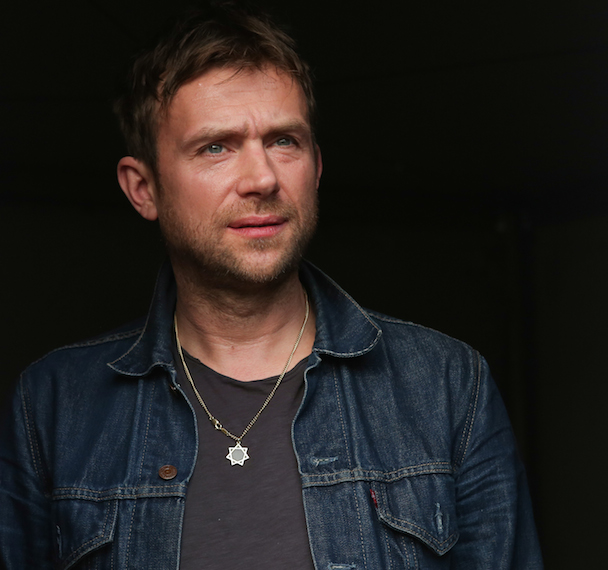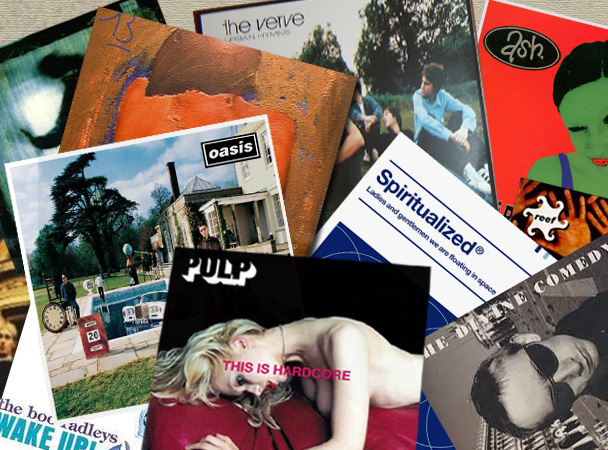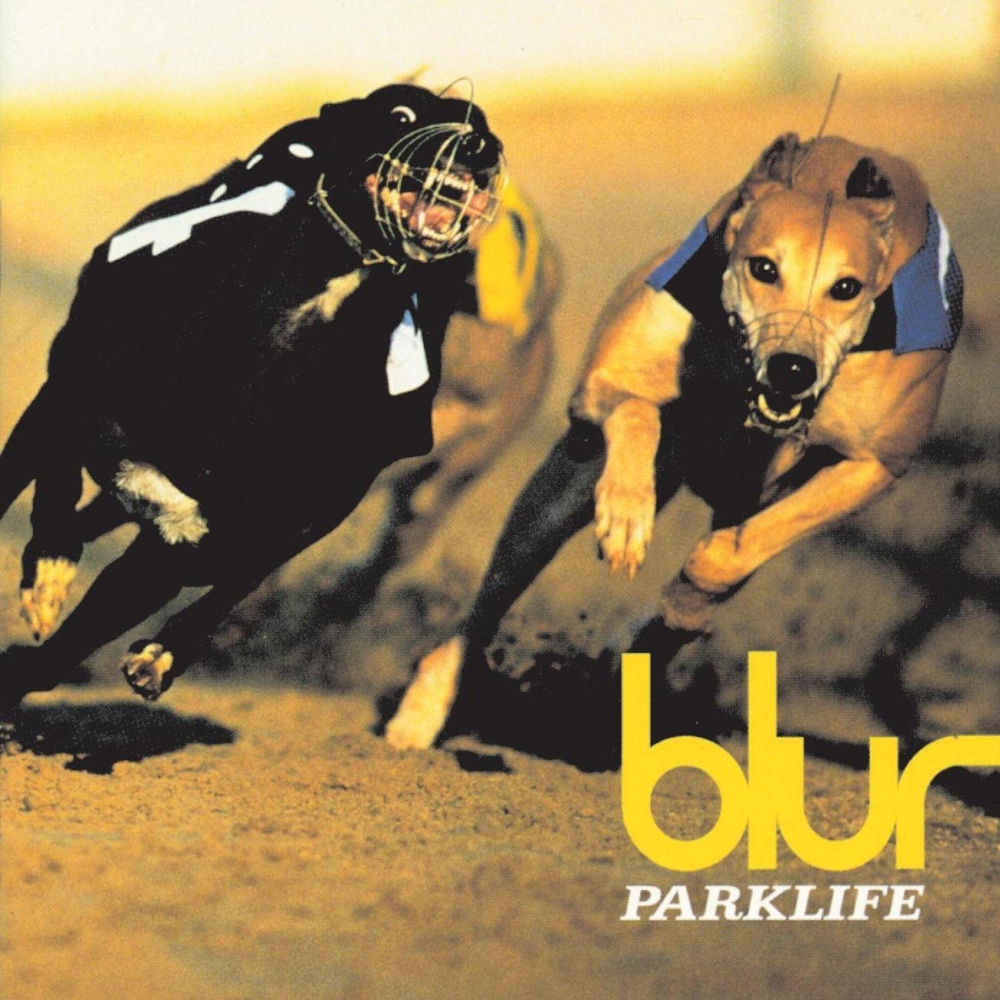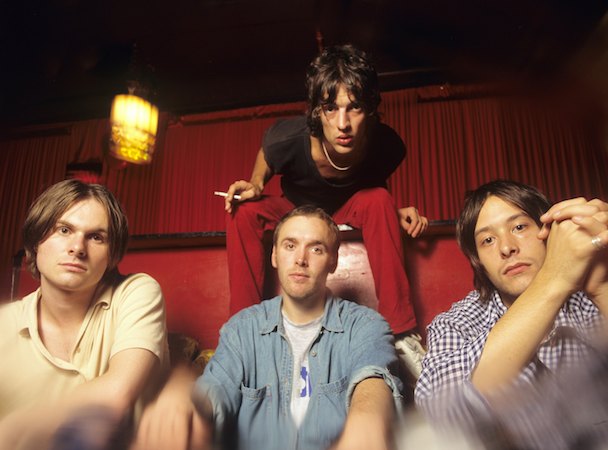Britpop stars like Damon Albarn weren't supposed to age. This is often true of famous musicians, of course, from pop ingenues to boy bands to punk rockers, but there was a specific element of youthfulness that accompanied Britpop. Sure, Jarvis Cocker was always kind of old before his time, but Britpop as a genre, even when it was incisive and took on the whole scope of British culture, also had an inherent boyishness and, at times, brattiness to it -- no doubt partially attributable, in this instance, to the way in which the British tabloids helped a seething rivalry between Albarn and Oasis' Noel Gallagher fester in the media. Blur's music sounded like a young man's game, even when it took on its darkest topics and broke down into a real bleary-eyed world-weariness in the late '90s. You look at old footage of Albarn, and you hear him sing a song like "The Universal," and you think: How is this man supposed to mature gracefully into the next stage of his life and career? How does one of the the stars at the forefront of a movement like Britpop grow old?
In most cases, the answer is probably "they don't" because the people in question vanish from the spotlight. For Albarn, most people's answer to at least the second question is that, well, he hasn't. From afar, Albarn seems abnormally youthful, two faint smile lines the only things etched by time into that pop-star face. I say "from afar," because when I approach him on the Hyatt's back patio overlooking the Colorado River in Austin on a sunny March afternoon during South By Southwest, the first thing I notice is that Damon Albarn has indeed aged. Up close you can see the wrinkles, and the way his hair creeps a bit further up his scalp than you'd realize from promo shots. The man has a gold tooth. Blame it partially on jet lag and his 1:30AM set the preceding night, but fatigue has visibly nestled under his eyes. Of course he still appears unnaturally young and well-preserved for a 46-year-old man who has spent so many years on the road and some years nursing a heroin habit. He even dresses the part of the still-with-the-moment rockstar dad: jeans topped by a denim jacket of a slightly different tone, desert boots with striped socks poking up out of them, a cigarette cradled in one hand. But there's also a comfort to realizing that Albarn's both the pop star you imagine and hope for, and still a human. He has the look of a man who has seen some heavy years. This is important, because his new record, Everyday Robots , is more so about the passage of time than it is about anything else.
Somehow, Everyday Robots is Albarn's first official solo album. Perpetually working on new projects, Albarn has played everything from frontman (Blur), to a sort of hybrid solo/collage artist (all of Gorillaz' music was written by Albarn, but was reliant on the contributions of artist Jamie Hewlett, as well as a wide array of other musicians), to a backseat bandleader with projects like Rocket Juice & The Moon or Mali Music, to writing full operas like Dr. Dee or Monkey: Journey To The West. In the midst of that, there's never been a standalone, full-fledged "Damon Albarn" album until now. Appropriately, it's the most thoroughly autobiographical work Albarn's yet composed. Where there are plenty of instances of his personal experiences and outlooks in his music through the years, almost every single line on Everyday Robots actually occurred in his life, going as far back as 1976, when he was 8 years old. "That's how I accepted I was making a solo record, not just another record," he says.
If the content of what makes this a Damon Albarn album presented itself somewhat plainly, the structure is a harder thing to chase down. Because he keeps office at hours at his studio -- "Religiously, 10:30AM-5:00PM. I get anxious if it gets to quarter to six" -- Albarn always has a surfeit of music built up. He writes everything the same way, never starting from a point of "This one might be a Gorillaz song someday" or "This one will go to the side for the eventual solo album," but letting the songs evolve "sonically or thematically" into whatever they should be. ("What makes a Gorillaz song different than anything else I do is very simple: I just use synthesizers," he wryly elaborates.) When it came time to begin the process of recording Everyday Robots, Albarn went into the studio with XL Recordings head Richard Russell and brought him a selection of songs. The only one from the initial batch that appears on Everyday Robots is "Mr. Tembo," a story of Albarn meeting a baby elephant in Tanzania. He initially included it as something of a joke, despite clarifying the song itself isn't meant as a joke; it wound up one of the only light-hearted or relatively uptempo moments on the record.
[videoembed size="full_width" alignment="center"][/videoembed]
Instead, most of Everyday Robots was written in the studio, sometimes spurred by Russell's involvement. One song, "Photographs (You Are Taking Now)," evolved from the Timothy Leary vocal sample Russell brought in, telling Albarn to use it as a starting point and see what came out of it. It's one of many instances of different voices flitting in and out of the record, from the very beginning of its opening title track, to the distant playground noises of "Hostiles," to Brian Eno's guest spot on closer "Heavy Seas Of Love." Albarn attributes much of it to the tradition of sampling in hip-hop. "For Rich [Russell] and I, that's a big part of who we are," he explains.
The way voices drift in and out of Albarn's own stories also helps establish the other major strand of Everyday Robots. The mingling of experience and identities feels endemically 21st century, and as the title suggests, Albarn's solo outing is interested in how technological advances alter the way we interact with each other, and the ways we pass through the world.
The whole concept, and the record's title, stemmed from a scene depicted in the album's title track. "The genesis of that was in one of those notorious traffic jams leaving LA, going to Coachella," Albarn laughs. He goes on to describe the scene: several hours spent crawling, stop-start, across the desert, able to look into people's cars and watch them kill time on their phones. If he turned his head the other way, it was all the severities of nature: the way the late-afternoon sun cast long shadows under standing stones running out to the horizon. The strange pulse of "Everyday Robots" is rooted in that slow drift through desert traffic; its story becomes a meditation on our engagement with technology vs. our engagement with the events and images around us in real time. Other songs extend it outward. "Lonely Press Play" deals with "how much we gravitate with our thumb and our index finger to that little triangle pointing to the right," he says. "It's pretty mad, how much that's become part of the human condition." "Photographs" travels in similar territory, questioning how much of a moment we experience if we're pausing to capture it for sharing later, if we're plagued in the present by the anxiety of properly remembering it in the future.
"It's contemplative," Albarn's quick to qualify when I ask him about the album's title having a negative connotation. "I embrace [technology]. I've surprised myself," he continues. And it's true -- Albarn was, after all, an early adopter of the iPad, and crafted the Gorillaz album The Fall with an app while he toured America. Still, even if Everyday Robots stops far short of technophobia, Albarn doesn't shy away from asking the big questions about the potential drawbacks of technological progress, of wondering if all this stuff is altering our fundamental behavior for the worse. "I love the creativity and the freedom that technology enables you to have," he says. "But on this record it's a question: We're in a moment of extraordinary transition as a species, and what is the outcome of that? Are we going to become closer to ourselves or are we going to become more distant?"
Ironically, for an album laden with themes of how technology is changing our lives, Everyday Robots is one of the most consistently organic-sounding Albarn releases. He has made records stacked with hip-hop beats and synth layers, and this is not one of them. Rather, it's all strings, piano, acoustic guitar, and occasional, often sparse percussion; if there's any electric guitar on here it's subdued enough to pass by without being noticed. At times the contrast is deployed in ways that deepen the songs. "Lonely Press Play" is based on an off-kilter, loping beat, but as it draws to a quiet close the beat steadies into a 4/4 pulse akin to a heartbeat that quickens and segues right into "Mr. Tembo," the record's liveliest -- and thus, "most human" -- song. Moments like this get at why the interplay between digital and human is at the core of Everyday Robots. Throughout, Albarn questions how the organic and artificial elements of our lives interact and change one another.
At moments, Albarn still seems in genuine awe of the world around him, perhaps more so than when he was a younger man. We lose ourselves for a few minutes comparing notes on our experiences traveling through different parts of the Chinese countryside, and then again in a discussion of some bizarre birds perched in trees above us that are making some Jurassic Park-level croaks. A video for "Heavy Seas Of Love" was released earlier this week, and it captures that mix found throughout Everyday Robots. It's a video journal of the places Albarn passed through during the album's creation, cataloged and slightly digitally altered, just as memories pass between bare confessionals and samples alike throughout these songs.
[videoembed size="full_width" alignment="center"][/videoembed]
It takes a few listens, but the beauty that reveals itself in Everyday Robots is in the interplay Albarn has set up between themes and sounds that should seemingly not mesh together. At the same time he was digging into the recesses of his memory and personal experiences, Albarn was also navigating the big abstractions of digital culture. It's all ineffable: one an organic function, another a digital one, and either could be used to enrich or complicate the other. "In a way, we're losing our senses," Albarn muses. "We're losing our ability to listen and everything is done with headphones. We're losing our ability to see because we're constantly using this eye that we have on our phones." In moments like this, he does seem a little anxious -- there's an unspoken but plainly evident "At what cost?" being leveled. Albarn stops short of conclusions. The lyrics on Everyday Robots are strictly meditative, whether on the past or on the present. But it's telling that he was handed an old Timothy Leary quote and used it to elucidate a contemporary condition. Though Everyday Robots is positioned as almost a memoir of sorts, it also seeks to reconcile how Albarn experienced his life then and how he experiences it now.
Before my time with Albarn is over, I need to ask him about his memories once more, but about a very specific time in his life. Though he claims it is a total coincidence, Everyday Robots will be released mere days from the 20th anniversary of the release of Parklife, Blur's breakthrough album and in many ways the proper beginning of the Britpop movement. In 2006, two years after Parklife turned 10, Albarn released The Good, The Bad, & The Queen -- a (so far) one-off that marked his return to writing about London, albeit a far different city than the one he'd pulled apart throughout Parklife. Consider it a pseudo-halfway point. If Everyday Robots has a sonic forebear in Albarn's past work, it's in a handful of sadder Gorillaz songs and in the moodiness and gently plucked acoustics of The Good, The Bad, & The Queen. But the Damon Albarn behind Everyday Robots is a very different man than the one who made those records. Even as we sit and discuss an album that's explicitly about his life, it seems odd to ask Albarn about the legacy of Britpop. That Damon Albarn ... that seems like a different person.
"The greatest legacy for me is that Noel [Gallagher] and me are mates now," he says with a laugh. It plays out as a deflection at first -- he goes on about Gallagher for a moment, then pauses, resets the topic. "Obviously the fact that it's still being talked about means something happened," he ventures. "It was so big and so important to everyone at the time, and had so many mad, illogical nuances based on geography and class. I don't think there's been anything like it [since]. I think it was the end of that idea, the tribes." Due to a whole host of reasons technological, cultural, and pop-cultural, Britpop represented the end of something -- like grunge or mainstream alternative in America, it was the last time you could point to a guitar-based movement defining a generation.
Without saying it explicitly, Albarn seems to locate Britpop in a distant, sealed-off time period. Which is fascinating and fitting when you consider that Albarn is a sort of survivor of Britpop -- the one who managed to get away, who might not have grown old as you expected, but understood where things had gone and where they were going, and reinvented himself a few times over.
Which is why it's so hard to imagine him making new music with Blur. It's hard to imagine, in general, that this is the man who did those things, or even the man who was behind Gorillaz. He has all the stories to prove that stuff happened, though. A good deal of them are there on Everyday Robots, nestled in its hushed gray tones. There will probably never be another musical moment or album with quite the magnitude and relative universality as what Albarn experienced in the '90s. Something as subdued as Everyday Robots seems more appropriate for the man I meet today. It seems, perhaps paradoxically, a more logical conclusion to a 20-year arc starting with Parklife than some big Blur reunion album would. Damon Albarn seems like a man who is comfortable letting the past remain the past. He strode back into the lobby, hands shoved into his jeans. Nobody seemed to recognize him.






